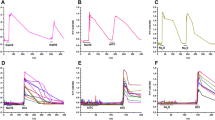Summary
-
1.
Intraarterial injection of capsaicin (threshold dose 0.3 μg) into the isolated perfused rabbit ear causes a dose-dependent reflex fall in blood pressure by stimulation of chemosensitive nociceptors.
-
2.
Infusion of capsaicin (1 and 10 μg/ml) into the isolated rabbit ear dose-dependently stimulates prostaglandin biosynthesis, equally in innervated and chronically denervated preparations, therefore mainly in extraneuronal tissue. The capsaicin-induced prostaglandin E release is dependent on the presence of extracellular Ca2+.
-
3.
The nociceptive reflex fall in blood pressure induced by i.a. injection of bradykinin is progressively enhanced under infusion of 1 μg/ml capsaicin whereas that induced by acetylcholine is not. Its enhancement is explained by the capsaicin-induced increased amount of prostaglandin E at the nociceptor sites.
-
4.
Infusion of 10 μg/ml capsaicin renders the nociceptors insensitive to effects of bradykinin and acetylcholine.
-
5.
Although the stimulation of nociceptors by capsaicin in a small dose includes the release of prostaglandin E from the surrounding tissue, it cannot be said whether a prostaglandin-mediated mechanism is also involved in the long lasting functional impairment of chemosensitive fibres induced by high doses of capsaicin.
Similar content being viewed by others
References
Beck, P. W., Handwerker, H. O.: Bradykinin and serotonin effects on various types of cutaneous nerve fibres. Pflügers Arch. Ges. Physiol.347, 209–222 (1974)
Coleridge, H. M., Coleridge, J. C. G., Kidd, C.: Role of the pulmonary arterial baroreceptors in the effects produced by capsaicin in the dog. J. Physiol. (Lond.)170, 272–285 (1964)
Collier, H. O. J., McDonald-Gibson, W. J., Saeed, S. A.: Stimulation of prostaglandin biosynthesis by drugs: Effects in vitro of some drugs affecting gut function. Br. J. Pharmacol.58, 193–199 (1976)
Damas, J., Deby, C.: Sur la liberation des prostaglandines et de leur précurseurs, par la bradykinine. Arch. Int. Physiol. Biochim.84, 293–304 (1976)
Fjällebrant, N., Iggo, A.: The effect of histamine, 5-hydroxytryptamine and acetylcholine on cutaneous afferent fibres. J. Physiol. (Lond.)156, 578–590 (1961)
Gamse, R., Molnar, A., Lembeck, F.: Substance P release from spinal cord slices by capsaicin. Life Sci.25, 629–636 (1979)
Hökfelt, T., Kellerth, J. O., Nilsson, G., Pernow, B.: Experimental immunohistochemical studies on the localization and distribution of substance P in cat primary sensory neurones. Brain Res.100, 235–252 (1975)
Jancsó, N., Jancsó-Gábor, A., Szolcsányi, J.: Direct evidence for neurogenic inflammation and its prevention by denervation and by pretreatment with capsaicin. Br. J. Pharmacol. Chemother.31, 138–151 (1967)
Jancsó, N., Jancsó-Gábor, A., Szolcsányi, J.: The role of sensory nerve endings in neurogenic inflammation induced in human skin and the eye and paw of the rat. Br. J. Pharmacol. Chemother.32, 32–41 (1968)
Jessell, T. M., Mudge, A. W., Leeman, S. E., Yaksh, T. L.: Release of substance P and somatostatin, in vivo, from primary afferent terminals in mammalian spinal cord. Proc. Soc. Neurosci.5, 611 (1979)
Joó, F., Szolcsányi, J., Jancsó-Gábor, A.: Mitochondrial alterations in the spinal ganglion cells of the rat accompanying the longlasting sensory disturbance induced by capsaicin. Life Sci.8, 621–626 (1969)
Juan, H.: Mechanism of action of bradykinin-induced release of prostaglandin E. Naunyn-Schmiedeberg's Arch. Pharmacol.300, 77–85 (1977)
Juan, H.: Inhibition of the algesic effect of bradykinin and acetylcholine by mepacrine. Naunyn-Schmiedeberg's Arch. Pharmacol.301, 23–27 (1977a)
Juan, H.: Prostaglandins as modulators of pain. Gen. Pharmacol.9, 403–409 (1978)
Juan, H.: Role of calcium in prostaglandin E release induced by bradykinin and the ionophore A 23187. Naunyn-Schmiedeberg's Arch. Pharmacol.307, 177–183 (1979)
Juan, H., Lembeck, F.: Action of peptides and other algesic agents on paravascular pain receptors of the isolated perfused rabbit ear. Naunyn-Schmiedeberg's Arch. Pharmacol.283, 151–164 (1974)
Juan, H., Lembeck, F.: Release of prostaglandins from the isolated perfused rabbit ear by bradykinin and acetylcholine. Agents Actions6, 642–645 (1976)
Juan, H., Lembeck, F.: Prostaglandin F2α reduces the algesic effect of bradykinin by antagonizing the pain enhancing action of endogenously released prostaglandin E. Br. J. Pharmacol.59, 385–391 (1977)
Lembeck, F., Juan, H.: Interaction of prostaglandins and indomethacin with algesic substances. Naunyn-Schmiedeberg's Arch. Pharmacol.285, 301–313 (1974)
Lembeck, F., Holzer, P.: Substance P as neurogenic mediator of antidromic vasodilation and neurogenic plasma extravasation. Naunyn-Schmiedeberg's Arch. Pharmacol.310, 175–183 (1979)
Lembeck, F., Popper, H., Juan, H.: Release of prostaglandins by bradykinin as an intrinsic mechanism of its algesic effect. Naunyn-Schmiedeberg's Arch. Pharmacol.294, 69–73 (1976)
Pórszász, J., György, J. L., Pórszász-Gibiszer, K.: Cardiovascular and respiratory effects of capsaicin. Acta Physiol. Hung.8, 61–76 (1955)
Pórszász, J., Such, Gy., Pórszász-Gibiszer, K.: Circulatory and respiratory chemoreflexes. Analysis of the site of action and receptor types of capsaicin. Acta Physiol. Hung.12, 189–205 (1957)
Szolcsányi, J.: A pharmacological approach to elucidation of the role of different nerve fibres and receptor endings in mediation of pain. J. Physiol. (Paris)73, 251–259 (1977)
Szolcsányi, J.: Effect of pain producing chemical agents on the single fiber activity of slowly conducting afferent fibres. Acta Physiol. Acad. Sci. Hung. (in press, 1980)
Szolcsányi, J., Jancsó-Gábor, A., Joó, E.: Functional and fine structural characteristics of the sensory neuron blocking effect of capsaicin. Naunyn-Schmiedeberg's Arch. Pharmacol.287, 157–169 (1975)
Toh, C. C., Lee, T. S., Kiang, A. K.: The pharmacological actions of capsaicin and analogues. Br. J. Pharmacol.10, 175–182 (1955)
Vargaftig, B. B.: The pharmacology of slow reacting substance C and of arachidonic acid. Agents Actions3, 357–365 (1973)
Virus, M., Gebhart, F.: Pharmacological actions of capsaicin: Apparent involvement of substance P and serotonin. Life Sci.25, 1273–1284 (1979)
Youlten, L. J. F., McCall, E.: Prostaglandins, completment and cellular migration in carageenin inflammation. In: The role of prostaglandins in inflammation, G. P. Lewis, ed.), pp. 26–33. Bern-Stuttgart-Wien: Huber 1976
Author information
Authors and Affiliations
Rights and permissions
About this article
Cite this article
Juan, H., Lembeck, F., Seewann, S. et al. Nociceptor stimulation and PGE release by capsaicin. Naunyn-Schmiedeberg's Arch. Pharmacol. 312, 139–143 (1980). https://doi.org/10.1007/BF00569722
Received:
Accepted:
Issue Date:
DOI: https://doi.org/10.1007/BF00569722




